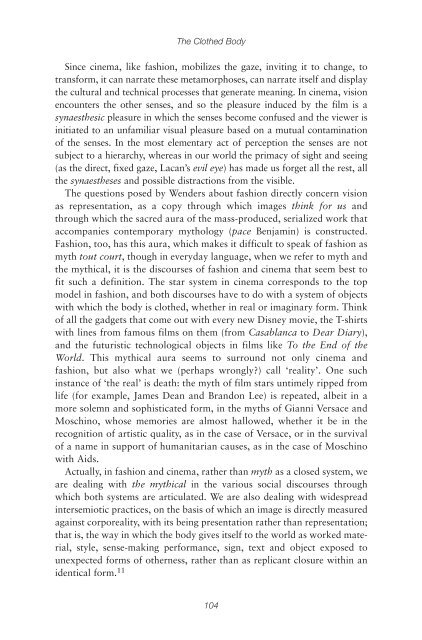You also want an ePaper? Increase the reach of your titles
YUMPU automatically turns print PDFs into web optimized ePapers that Google loves.
<strong>The</strong> <strong>Clothed</strong> <strong>Body</strong><br />
Since cinema, like fashion, mobilizes the gaze, inviting it to change, to<br />
transform, it can narrate these metamorphoses, can narrate itself and display<br />
the cultural and technical processes that generate meaning. In cinema, vision<br />
encounters the other senses, and so the pleasure induced by the film is a<br />
synaesthesic pleasure in which the senses become confused and the viewer is<br />
initiated to an unfamiliar visual pleasure based on a mutual contamination<br />
of the senses. In the most elementary act of perception the senses are not<br />
subject to a hierarchy, whereas in our world the primacy of sight and seeing<br />
(as the direct, fixed gaze, Lacan’s evil eye) has made us forget all the rest, all<br />
the synaestheses and possible distractions from the visible.<br />
<strong>The</strong> questions posed by Wenders about fashion directly concern vision<br />
as representation, as a copy through which images think for us and<br />
through which the sacred aura of the mass-produced, serialized work that<br />
accompanies contemporary mythology (pace Benjamin) is constructed.<br />
Fashion, too, has this aura, which makes it difficult to speak of fashion as<br />
myth tout court, though in everyday language, when we refer to myth and<br />
the mythical, it is the discourses of fashion and cinema that seem best to<br />
fit such a definition. <strong>The</strong> star system in cinema corresponds to the top<br />
model in fashion, and both discourses have to do with a system of objects<br />
with which the body is clothed, whether in real or imaginary form. Think<br />
of all the gadgets that come out with every new Disney movie, the T-shirts<br />
with lines from famous films on them (from Casablanca to Dear Diary),<br />
and the futuristic technological objects in films like To the End of the<br />
World. This mythical aura seems to surround not only cinema and<br />
fashion, but also what we (perhaps wrongly?) call ‘reality’. One such<br />
instance of ‘the real’ is death: the myth of film stars untimely ripped from<br />
life (for example, James Dean and Brandon Lee) is repeated, albeit in a<br />
more solemn and sophisticated form, in the myths of Gianni Versace and<br />
Moschino, whose memories are almost hallowed, whether it be in the<br />
recognition of artistic quality, as in the case of Versace, or in the survival<br />
of a name in support of humanitarian causes, as in the case of Moschino<br />
with Aids.<br />
Actually, in fashion and cinema, rather than myth as a closed system, we<br />
are dealing with the mythical in the various social discourses through<br />
which both systems are articulated. We are also dealing with widespread<br />
intersemiotic practices, on the basis of which an image is directly measured<br />
against corporeality, with its being presentation rather than representation;<br />
that is, the way in which the body gives itself to the world as worked material,<br />
style, sense-making performance, sign, text and object exposed to<br />
unexpected forms of otherness, rather than as replicant closure within an<br />
identical form. 11<br />
104

















